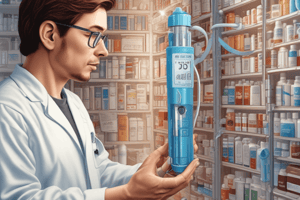Podcast
Questions and Answers
Match the type of diabetes with its characteristic treatment approach:
Match the type of diabetes with its characteristic treatment approach:
Type 1 = Major change is we no longer wait to use drugs Type 2 = Dietary measures are the cornerstone of treatment
Match the insulin type with its duration of action:
Match the insulin type with its duration of action:
Lispro = Short duration—rapid acting NPH = Intermediate duration Glargine = Long duration Aspart = Short duration—slower acting
Match the insulin administration method with its description:
Match the insulin administration method with its description:
Subcutaneous = Using a syringe and needle Insulin pens = Infusion devices such as IV pumps Infusion devices = Not a recommended method Oral = Not applicable for insulin administration
Match the factor with its effect on insulin needs:
Match the factor with its effect on insulin needs:
Match the premixed insulin type with its characteristic:
Match the premixed insulin type with its characteristic:
Match the insulin storage instruction with its description:
Match the insulin storage instruction with its description:
Match the following medication with its corresponding indication:
Match the following medication with its corresponding indication:
Match the following side effects with the corresponding medication:
Match the following side effects with the corresponding medication:
Match the following laboratory test with its corresponding indication:
Match the following laboratory test with its corresponding indication:
Match the following medication with its corresponding mechanism of action:
Match the following medication with its corresponding mechanism of action:
Match the following condition with its corresponding signs and symptoms:
Match the following condition with its corresponding signs and symptoms:
Match the following medication with its corresponding usage:
Match the following medication with its corresponding usage:
Match the oral antidiabetic medication with its primary mechanism of action:
Match the oral antidiabetic medication with its primary mechanism of action:
Match the oral antidiabetic medication with its potential side effect:
Match the oral antidiabetic medication with its potential side effect:
Match the insulin therapy situation with its corresponding effect:
Match the insulin therapy situation with its corresponding effect:
Match the oral antidiabetic medication with its characteristics:
Match the oral antidiabetic medication with its characteristics:
Match the oral antidiabetic medication with its adverse effect:
Match the oral antidiabetic medication with its adverse effect:
Match the oral antidiabetic medication with its target organ:
Match the oral antidiabetic medication with its target organ:
Flashcards are hidden until you start studying




